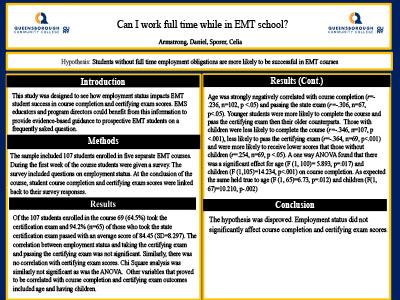ABSTRACTS
Can I Work Full Time While in EMT School?Author: Daniel Armstrong, Celia Sporer, Ella Orsino, and Eric Orisino | | Associate Authors:
Introduction: This study was designed to examine how employment status impacts EMT student success in course completion and certifying exam scores. EMS educators and program directors could benefit from this information to provide evidence-based guidance to prospective EMT students on a frequently asked question. Hypothesis: Students without full-time employment obligations are more likely to be successful in EMT courses. Methods: The sample included 107 students enrolled in five separate EMT courses. Students were given a survey during the first week of the course. The survey included questions on employment status. At the conclusion of the course, student course completion and certifying exam scores were linked back to their survey responses. Results: Of the 107 students enrolled in the course, 69 (64.5%) took the certification exam, and 94.2% (n = 65) of those who took the state certification exam passed with an average score of 84.45 (SD = 8.297). The correlation between employment status and taking the certifying exam and passing the certifying exam was not significant. Similarly, there was no correlation with certifying exam scores. Chi-square analysis was similarly not significant nor was the ANOVA. Other variables that were correlated with course completion and certifying exam outcomes included age and having children. Age was strongly negatively correlated with course completion (r = −.236, n = 102, p < .05) and passing the state exam (r = −.306, n = 67, p < .05). Younger students were more likely to complete the course and pass the certifying exam then their older counterparts. Those with children were less likely to complete the course (r = −.346, n = 107, p < .001), less likely to pass the certifying exam (r = −.364, n = 69, p < .001), and more likely to receive lower scores that those without children (r = .254, n = 69, p < .05). A one-way ANOVA found a significant effect for age (F (1, 100) = 5.893, p = .017) and children (F (1, 105) = 14.234, p < .001) on course completion. As expected, the same held true to age (F (1, 65) = 6.73, p = .012) and children (F (1, 67) = 10.210, p = .002). Conclusion: The hypothesis was disproved. Employment status did not significantly affect course completion and certifying exam scores.
|

